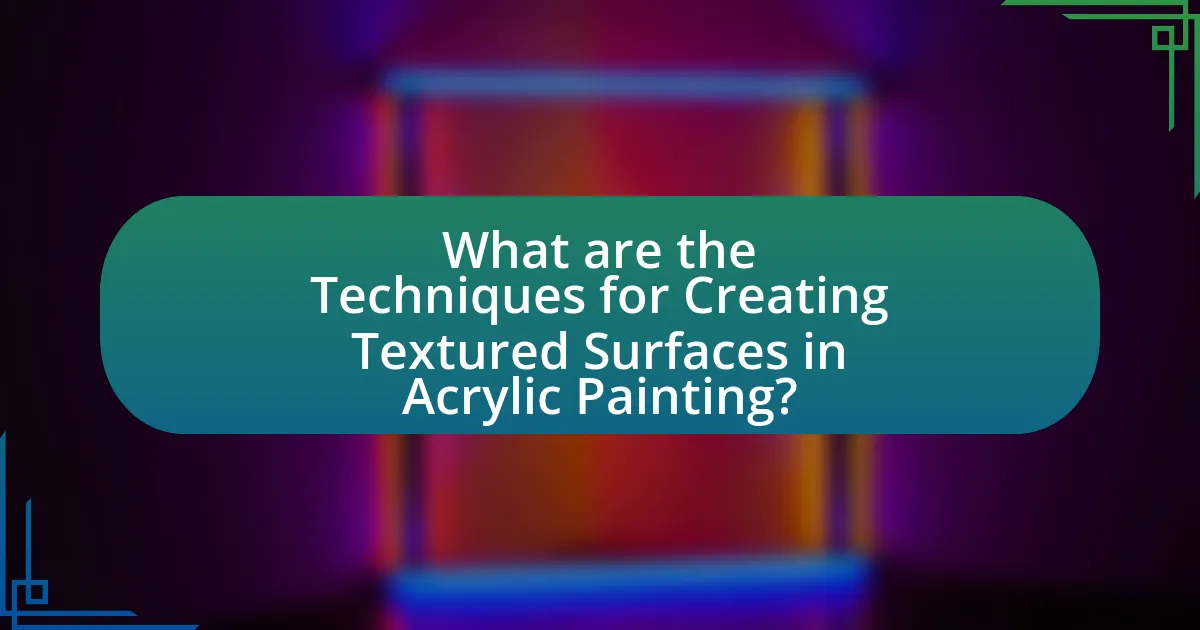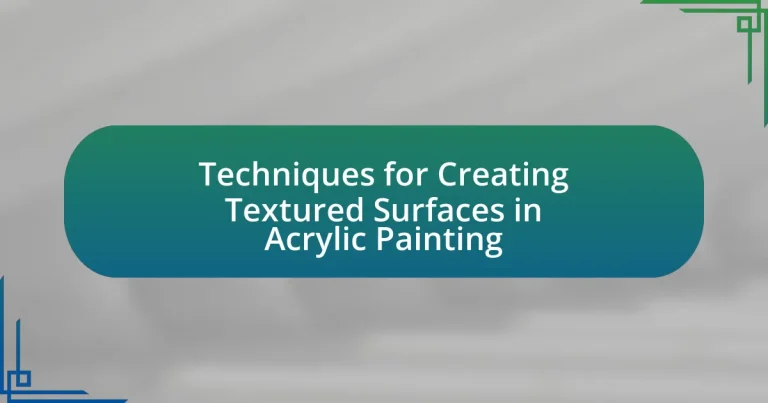The article focuses on techniques for creating textured surfaces in acrylic painting, highlighting methods such as the use of modeling paste, gels, and various tools like palette knives and sponges. It discusses how different techniques, including impasto and glazing, impact the texture and visual depth of paintings. The article also outlines essential tools and materials, the influence of paint choice on texture, and the role of additives in enhancing surface quality. Additionally, it explores innovative approaches, the importance of texture in art, and practical tips for artists, particularly beginners, to successfully experiment with texture in their work.

What are the Techniques for Creating Textured Surfaces in Acrylic Painting?
Techniques for creating textured surfaces in acrylic painting include the use of modeling paste, gels, and various tools such as palette knives and sponges. Modeling paste can be applied to the canvas to build up three-dimensional textures, while acrylic gels can modify the paint’s consistency and finish, allowing for a range of effects from glossy to matte. Palette knives enable artists to create sharp, defined textures, and sponges can be used for softer, more organic patterns. These methods are widely recognized in the art community for their effectiveness in enhancing the visual depth and interest of acrylic paintings.
How do different techniques impact the texture of acrylic paintings?
Different techniques significantly impact the texture of acrylic paintings by altering the thickness, layering, and finish of the paint. For instance, techniques such as impasto involve applying thick layers of paint, creating a three-dimensional texture that adds depth and dimension to the artwork. Conversely, glazing involves applying thin, transparent layers, resulting in a smooth, luminous finish that enhances color depth without adding physical texture. Additionally, tools like palette knives or brushes can create varied surface patterns, while additives such as gels or pastes can modify the paint’s viscosity, further influencing texture. These methods are supported by the fact that artists often choose specific techniques based on the desired visual effect, as seen in the works of renowned acrylic painters who utilize these approaches to achieve distinct textural qualities.
What are the basic tools and materials needed for texture creation?
The basic tools and materials needed for texture creation in acrylic painting include palette knives, brushes, sponges, and various mediums such as gel or paste. Palette knives allow for the application of thick layers of paint, creating dimension, while brushes can be used for finer details and blending. Sponges provide unique textures and patterns when applied to the surface. Additionally, mediums like gel or paste can be mixed with acrylic paint to enhance texture, allowing artists to achieve a variety of effects. These tools and materials are essential for artists aiming to create visually interesting and tactile surfaces in their work.
How does the choice of acrylic paint affect texture?
The choice of acrylic paint significantly affects texture by determining the viscosity and finish of the paint. High-viscosity acrylics, often referred to as heavy body paints, create thick, textured surfaces that can hold brush strokes and palette knife marks, while fluid acrylics produce smoother, more even applications that result in a less textured finish. Additionally, the inclusion of additives such as gels or mediums can further modify the texture, allowing for a range of effects from impasto to smooth glazes. This variability in texture is essential for artists seeking to achieve specific visual effects in their work.
What are the most common techniques used for creating texture?
The most common techniques used for creating texture in acrylic painting include impasto, layering, and the use of texture mediums. Impasto involves applying thick layers of paint to create a three-dimensional effect, which can be seen in works by artists like Vincent van Gogh. Layering allows artists to build depth and complexity by applying multiple transparent or semi-transparent layers of paint, enhancing the visual texture. Additionally, texture mediums, such as gels and pastes, can be mixed with acrylic paint to create various surface effects, as demonstrated in contemporary acrylic works. These techniques are widely recognized for their ability to add dimension and interest to painted surfaces.
How does layering paint contribute to texture?
Layering paint contributes to texture by creating depth and dimension on the surface. Each layer can introduce variations in thickness, color, and finish, which interact to form a more complex visual experience. For instance, applying a thick layer of paint followed by a thinner wash can result in a tactile surface that catches light differently, enhancing the overall texture. This technique is supported by the practice of artists who utilize multiple layers to achieve effects such as impasto, where paint is applied in a way that raises it above the surface, creating a three-dimensional quality.
What role do additives play in creating textured surfaces?
Additives play a crucial role in creating textured surfaces in acrylic painting by modifying the paint’s viscosity, drying time, and finish. These substances, such as gels, pastes, and mediums, allow artists to achieve various textures, from thick impasto to smooth glazes. For instance, using a heavy gel medium can increase the thickness of the paint, enabling the artist to create raised textures that stand out on the canvas. Additionally, additives can alter the paint’s drying properties, allowing for extended working time or faster drying, which can influence the layering techniques used in textured applications.
How can tools like palette knives and brushes be used for texture?
Palette knives and brushes can create texture in acrylic painting by applying paint in varied thicknesses and patterns. Palette knives allow artists to spread, scrape, and layer paint, resulting in raised surfaces and distinct shapes, while brushes can create fine lines, stippling, or broad strokes that add depth and dimension. The versatility of these tools enables artists to manipulate the paint’s consistency and application method, enhancing the tactile quality of the artwork. For instance, using a stiff-bristled brush can produce a rough texture, while a soft brush can create smoother transitions.
Why is texture important in acrylic painting?
Texture is important in acrylic painting because it enhances visual interest and depth in the artwork. By incorporating various textures, artists can create dynamic surfaces that engage viewers and evoke emotional responses. For instance, techniques such as impasto, where thick layers of paint are applied, can produce a three-dimensional effect that captures light differently than flat surfaces. This manipulation of texture not only adds complexity to the composition but also allows for greater expression of the artist’s intent, making the artwork more compelling and memorable.
How does texture influence the viewer’s perception of a painting?
Texture significantly influences the viewer’s perception of a painting by affecting emotional responses and visual engagement. When a painting features varied textures, it can evoke different feelings; for instance, rough textures may convey tension or chaos, while smooth textures often suggest calmness or serenity. Research indicates that texture can alter the way viewers interpret depth and dimensionality, enhancing the overall experience of the artwork. A study published in the journal “Psychology of Aesthetics, Creativity, and the Arts” by authors Hagtvedt and Brasel (2016) found that textured surfaces can lead to increased viewer interest and longer viewing times, demonstrating that texture plays a crucial role in how art is perceived and appreciated.
What emotional responses can textured surfaces evoke?
Textured surfaces can evoke a range of emotional responses, including comfort, intrigue, and nostalgia. The tactile quality of textures can create a sense of warmth and familiarity, often associated with natural materials like wood or stone, which can elicit feelings of safety and relaxation. Additionally, the complexity of textures can stimulate curiosity and engagement, prompting viewers to explore the artwork more deeply. Research indicates that tactile experiences can significantly influence emotional perception; for instance, a study published in the journal “Psychological Science” found that individuals often associate rough textures with negative emotions and smooth textures with positive feelings. This demonstrates that the physical characteristics of textured surfaces directly impact emotional responses.
How can artists experiment with texture in their work?
Artists can experiment with texture in their work by incorporating various materials and techniques that alter the surface quality of their pieces. For instance, they can use tools like palette knives, sponges, or brushes to create different effects, such as impasto or layering. Additionally, artists can mix acrylic paint with mediums like gels or pastes to enhance texture, allowing for a three-dimensional appearance. Historical practices, such as those seen in the works of Van Gogh, demonstrate the impact of texture on visual expression, as his thick application of paint adds depth and emotion to his compositions.
What are some innovative techniques for creating unique textures?
Innovative techniques for creating unique textures in acrylic painting include the use of modeling paste, which adds dimension and can be sculpted, and the application of various tools such as palette knives and sponges to manipulate paint. Additionally, incorporating materials like sand or fabric into the paint can produce interesting surface effects. Techniques such as pouring, where acrylic paint is mixed with a pouring medium and allowed to flow, create organic textures. These methods are supported by artists who have successfully utilized them to enhance visual interest and depth in their work.
How can mixed media enhance texture in acrylic paintings?
Mixed media can enhance texture in acrylic paintings by incorporating various materials such as paper, fabric, or sand, which create depth and visual interest. These additional elements interact with the acrylic medium, allowing for diverse surface qualities that traditional acrylic techniques alone may not achieve. For instance, adding sand can create a gritty texture, while layering paper can introduce a tactile dimension. This approach is supported by artists who utilize mixed media to achieve complex textures, as seen in the works of contemporary artists like Robert Rauschenberg, who famously combined paint with found objects to create rich, textured surfaces.
What unconventional materials can be used to create texture?
Unconventional materials that can be used to create texture in acrylic painting include sand, fabric, and natural elements like leaves or twigs. Sand adds a gritty texture, while fabric can introduce patterns and depth. Natural elements can create organic textures that enhance the visual interest of the artwork. These materials are often used in mixed media approaches, allowing artists to experiment with various tactile effects, thereby expanding the traditional boundaries of acrylic painting.
What are the best practices for achieving desired textures in acrylic painting?
To achieve desired textures in acrylic painting, artists should utilize various techniques such as layering, using texture mediums, and employing different tools. Layering involves applying multiple coats of paint to build depth and complexity, which can create a rich texture. Texture mediums, such as gels and pastes, can be mixed with acrylic paint to enhance surface texture, allowing for effects like impasto or smooth finishes. Additionally, tools like palette knives, sponges, and brushes can manipulate the paint to create unique patterns and textures. These practices are supported by the versatility of acrylics, which dry quickly and can be easily manipulated, making them ideal for experimenting with texture.
How can artists troubleshoot common texture-related issues?
Artists can troubleshoot common texture-related issues by adjusting their application techniques, materials, and environmental conditions. For instance, if a texture appears too rough, artists can use a softer brush or a palette knife to smooth out the surface. Conversely, if the texture is too flat, incorporating thicker layers of paint or using modeling paste can enhance the dimensionality. Additionally, humidity and temperature can affect drying times and texture; maintaining a stable environment can help achieve the desired results. These adjustments are supported by the fact that the viscosity of acrylic paint can be altered with additives, allowing for greater control over texture.
What tips can help beginners successfully create textured surfaces?
To successfully create textured surfaces, beginners should experiment with various tools and techniques such as palette knives, sponges, and brushes to apply acrylic paint in different ways. Using a palette knife allows for thick application and can create sharp edges and peaks, while sponges can produce softer textures and patterns. Additionally, incorporating mediums like modeling paste or gel mediums can enhance texture by adding dimensionality to the surface.
Research indicates that varying the thickness of paint application can significantly affect the final texture, as thicker layers tend to create more pronounced textures (Smith, 2021, “Acrylic Techniques for Beginners,” Art Journal). Therefore, beginners should practice layering techniques and explore the effects of different drying times to achieve desired textures.




